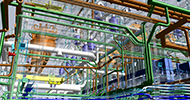In my previous blog, I introduced HxGN SMART Quality, a platform providing a smarter approach to quality data and measurement resource management. Here, I would like to elaborate on an aspect of that first blog: quality has its price!
By this I don’t just mean that high-quality products cost more, but that it also requires costly effort to generate and maintain a product’s quality. Achieving quality requires different measuring instruments and trained personnel, resources often perceived as not directly adding value to the product. HxGN SMART Quality offers a solution to optimise these ‘non-productive’ expenses.
The Resource Management part of HxGN SMART Quality gives customers the opportunity to increase the efficiency, effectiveness and capacity of the measuring resources used. On the one hand, unplanned downtime can be reduced by real-time monitoring of the measuring devices. On the other hand, the reporting functionality of HxGN SMART Quality allows detailed analysis of the collected machine data for continuous optimisation of the workload.
Many unscheduled standstills are caused by unspecified processes, for example if a part is measured using an outdated measuring routine. For this reason, HxGN SMART Quality offers an integrated workflow concept to accompany users step by step through defined and customer-specific processes to achieve the desired result. The current status of all live workflows is shown clearly including various additional information such as current step, progress or assignee information, and additional text information about the step. An automatic note is sent to the user in a timely manner; a note could, for example, inform the workflow owner about an open unsigned step or send assignment information to the assigned staff.
Likewise, the current status of the measuring device is clearly displayed using the integrated dashboard. This means that if a measuring device stops unexpectedly – say due to a forklift collision – measures can be taken to reduce the downtime.
Users can reproduce their company’s organisational structure within HxGN SMART Quality, starting with the entire factory, then subdividing by individual sub plants, and breaking it down further into individual measuring instruments. This allows measuring room managers to concentrate on their own measuring instruments, helping to optimise processes and drive productivity.
Besides the availability of purely measuring data, the number of data sources is now extended to include environmental data, such as temperature, humidity, pressure, etc. Another new data source is the measurement system itself, which can track the utilisation of a system to help customers make decisions about their assets. Both new data sources can be used in different timeframes. For instance, in the short-term they can be used to reduce unplanned downtime, or for maintenance or asset management in the long-term. These previously unused data sources and the actionable insights they provide are essential for organisations to streamline operations, drive productivity and work towards achieving the principles of Quality 4.0.
HxGN SMART Quality presents an exciting opportunity to create a more connected manufacturing environment. In my next blog, we’ll explore how these connected data points can be used to monitor stability criteria and environmental variables to ensure accurately measured values and efficient operations.














